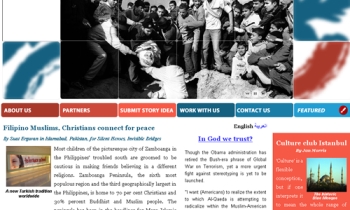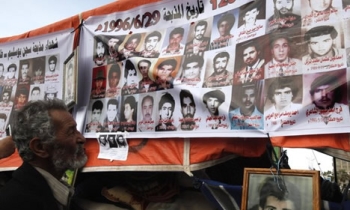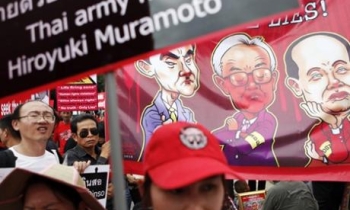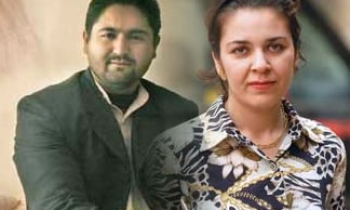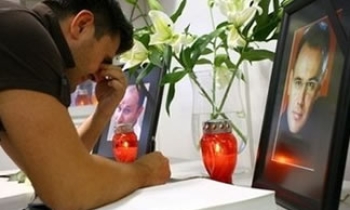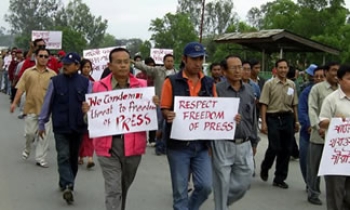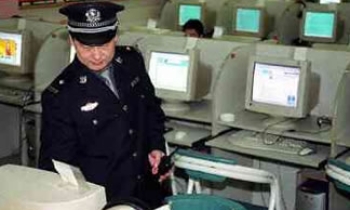Female journalists are increasingly being treated as soft targets by groups wanting to get their message of violence and control across. Two Afghan reporters and an Iraqi journalist who received numerous death threats for their work covering sectarian violence were killed last week, in a string of attacks against women journalists in conflict areas.
Sahar Hussein Ali al-Haydari was brutally murdered by four unidentified gunmen in the city of Mosul on June 7. Sahar was aware that her name was included in a death list comprising journalists and policemen which she mentioned in her World Press Freedom Day report last month. Al-Haydari is the second employee for Aswat al-Iraq to be killed this year. On May 30, Nazar Abdulwahid al-Radhi, was gunned down in the southern city of Al-Amarah.

The list had been circulated throughout Mosul asking for execution of all whose names were on the list. Sahar had been previously kidnapped and shot at in separate incidents, but had survived. She believed that the motive behind targeting journalists in Iraq was the fact that they were journalists, and the aim was to stifle their voices. Mosul is regarded as the second most dangerous city in the world for journalists, after Baghdad.
Joel Simon, Executive Director,Committee to Protect Journalists (CPJ), reacted, "We are outraged by the murder of our colleague Sahar Hussein Ali al-Haydari and offer our condolences to her family and friends." He said, "The constant threats and abductions she endured, and her eventual murder, are stark reminders of the sacrifice she made to tell the Iraqi story to the world."
"Our psychological state is unbalanced because we live and think in fear and worry, and always think about our destiny and that of our family members, relatives and friends," al-Haydari told the Press Gazette earlier this year, on being a woman journalist in Iraq. "But I have never thought about quitting, as journalism is my life and I really love it."
In Afghanistan too the situation is dire. Zakia Zaki, a prominent Afghan journalist, and Sanga Amaj, a television news presenter, were murdered in separate incidents in Kabul, less than a week apart from each other. Observers say that Amaj was targeted only because she was a prominent media figure in an environment that remains hostile to working women. According to the International Federation of Journalists (IFJ), Zaki had been critical of local warlords, who recently warned her to shut down the station, which could have triggered the killing.
“We are outraged at this brutal killing of a brave and respected journalist, and urge Afghan authorities to bring Zakia Zaki's killers to justice," said Simon. "This murder, which follows so closely on the heels of the killing of Shokiba Sanga Amaj, highlights the double hazard of being a woman and being a journalist in Afghanistan."
Two years ago, in May 2005, a presenter on the private Tolo Television, was shot dead in her Kabul home in a case that till date remains unsolved. Shaima Rezaee the deceased Afghan woman journalist had been criticised, for what some regarded, as her Western style and appearance.

"Women journalists have demonstrated particular tenacity and bravery in Afghanistan, Iraq, Uzbekistan and other Islamic countries, reporting on the human costs of conflict and the efforts of mostly male-dominated power structures to undermine democracy," said Anthony Borden, Executive Director, Institute of War & Peace Reporting (IWPR).
"Women are vital agents of democratic change in these societies, and the recent tragic killings demonstrate the depth and violence of opposition to their efforts," Borden said. IWPR supports local journalists in conflict areas and maintains extensive programming in Iraq. Al-Haydari was also a correspondent for the London-based IWPR.
The media sector in Afghanistan has grown rapidly since the fall of the Taliban in late 2001. However intolerance remains, and journalists and media workers are regularly subjected to threats and harassment from former warlords and conservatives. Reporters sans Frontières (RSF) describes press freedom as one of the few achievements of the past five years in the country. The group however warns that the sector remains fragile and that journalists feel the effects of deteriorating security, threats from warlords and conservative religious leaders, and a government that is feeling pressure from many sides.
Shukria Barekzai, a member of Afghanistan's parliament and a former editor of a women's magazine told Radio Free Europe / Radio Liberty (RFE/RL) that she was distressed over the broader signals of the murders of Zaki and Amaj. "I seriously condemn [these killings], and I'm also concerned about the murder of women who are unlawfully killed merely because they work for media organizations - they're journalists, they're intellectual women, and they fight for women's rights in Afghanistan. We are deeply worried about this," Barekzai says. Head of Afghanistan's Independent Journalists Association, Rahimullah Samander has highlighted that these recent murders have increased fear among journalists.

An obscure Islamist group in the Gaza Strip has even threatened to behead female television broadcasters if they do not wear strict Islamic dresses. The threat to “cut throats from vein to vein†was delivered by the Righteous Swords of Truth, a fanatical group that has previously claimed responsibility for bombing Internet cafes and music shops. The new threat was the first time the organisation targeted a specific group of people.
In Iran, Amnesty International has called on the Iranian authorities to release immediately and unconditionally two women detained in connection with their peaceful activities to promote equal rights for women, and to halt all trial proceedings that could result in the imprisonment of other prisoners of conscience and cease the harassment of those campaigning to uphold women’s rights in Iran.
For the most part, women are considered as a particularly vulnerable minority, where culture and other forms of orthodoxy frequently conspire against female professionals. The number of women working as journalists, reporters, or presenters has increased, but women still remain a clear minority in media sectors especially in Afghanistan.


